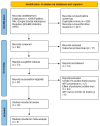The Effect of COVID-19 and COVID-19 Vaccination on Assisted Human Reproduction Outcomes: A Systematic Review and Meta-Analysis
- PMID: 39329870
- PMCID: PMC11431602
- DOI: 10.3390/diseases12090201
The Effect of COVID-19 and COVID-19 Vaccination on Assisted Human Reproduction Outcomes: A Systematic Review and Meta-Analysis
Abstract
The most discussed infectious disease is coronavirus disease 2019 (COVID-19), caused by the severe acute respiratory syndrome coronavirus 2 (SARS-CoV-2) virus. Many research endeavors have focused on the effects of the virus on reproductive organs, as these have also been shown to carry the receptors to which the virus attaches. The results of assisted reproductive technology (ART) have been significantly affected by the pandemic, with some in vitro fertilization (IVF) centers being closed due to the risk of further spread of the disease. According to World Health Organization statistics, 17.5% of adults worldwide suffered from fertility problems in 2023; in other words, one in six people in the world have reproductive health problems. As infertility is a growing problem in the modern world and new developments in assisted reproduction are always a topic of profound interest, it is important to understand the impact of SARS-CoV-2 on reproductive health. This systematic review aimed to examine studies describing patients undergoing ART procedures with a COVID-19-positive history and to shed light on the recent evidence on the safety of COVID-19 vaccination in the ART context. A meta-analysis was conducted to confirm the results of the systematic review. The results showed a significant difference in clinical pregnancy rates between the vaccinated and unvaccinated groups and an increased miscarriage rate in those with a COVID-19-positive history. However, no significant difference in clinical pregnancy and birth rates was found in participants with a previous COVID-19 infection. The results show that further studies and research are needed, even though the spread and impact of the virus have decreased. Evidence-based information for individuals and couples undergoing infertility treatment is vital to enable informed decision-making.
Keywords: ART; ART outcomes; COVID-19; COVID-19 vaccine; IVF; SARS-CoV-2.
Conflict of interest statement
The authors declare no conflicts of interest. The funders had no role in the study’s design, in the collection, analyses, or interpretation of data, in the writing of the manuscript, or in the decision to publish the results.
Figures









Similar articles
-
COVID-19 and human reproduction: A pandemic that packs a serious punch.Syst Biol Reprod Med. 2021 Feb;67(1):3-23. doi: 10.1080/19396368.2020.1855271. Syst Biol Reprod Med. 2021. PMID: 33719829 Review.
-
Effectiveness of a mixed lifestyle program in couples undergoing assisted reproductive technology: a study protocol.Reprod Health. 2023 Aug 1;20(1):112. doi: 10.1186/s12978-023-01652-6. Reprod Health. 2023. PMID: 37528465 Free PMC article.
-
In vitro fertilization and multiple pregnancies: an evidence-based analysis.Ont Health Technol Assess Ser. 2006;6(18):1-63. Epub 2006 Oct 1. Ont Health Technol Assess Ser. 2006. PMID: 23074488 Free PMC article.
-
SARS-CoV-2 vs. human gametes, embryos and cryopreservation.Syst Biol Reprod Med. 2021 Aug;67(4):260-269. doi: 10.1080/19396368.2021.1922537. Epub 2021 Jun 1. Syst Biol Reprod Med. 2021. PMID: 34060390
-
Impacts of the COVID-19 pandemic on Chinese assisted reproductive technology institutions and human sperm banks: reflections in the post-pandemic era.J Health Popul Nutr. 2023 Aug 18;42(1):82. doi: 10.1186/s41043-023-00422-1. J Health Popul Nutr. 2023. PMID: 37592335 Free PMC article. Review.
Cited by
-
The impact of COVID-19 infection on ART outcomes: a multicenter retrospective cohort study.J Ovarian Res. 2025 Jul 18;18(1):156. doi: 10.1186/s13048-025-01749-5. J Ovarian Res. 2025. PMID: 40682124 Free PMC article.
-
Ovarian function after COVID-19: long-term effects and vaccine safety in ART patients.J Assist Reprod Genet. 2025 Feb;42(2):563-576. doi: 10.1007/s10815-025-03403-x. Epub 2025 Jan 30. J Assist Reprod Genet. 2025. PMID: 39883303
References
Publication types
Grants and funding
LinkOut - more resources
Full Text Sources
Research Materials
Miscellaneous

